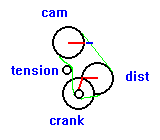Water Pump Replacement info
This describes changing the water pump and timing belt as well as
all the V-belts (a.k.a. fan belts) on a typical water cooled VW.
This is a fun repair and describes the procedure that I use for
my '86 Jetta with A/C. It should be the same for all second generation
Golfs and Jettas with the 1.8L engine. It will be very close for
most other Jettas and Golfs.
To replace the water pump, you need to remove the lower timing belt
cover and once thet is gone its easy to change the timing belt as well.
When this is done all the belts will be off the car so its a logical
time to replace all the belts.
It is generally recommended that the timing belt be replaced every 60,000
to 90,000 miles. It is also recommended that the cooling system be
flushed every 2 years. This will accomplish both.
The shop books claim this should take 4 hours but it could take
as many as 8 or as little as an hour. It is the most expensive of
the common maintenance procedures on a VW but doing it yourself will
save you a bit of cash since it is a timing consuming job. The parts
can be had for as little as $40 for generic after market parts to about
$160 for genuine VW parts from an dealer.
What is needed
- Tools: 6mm and 8mm allen wrench socket, 5mm allen wrench.
8mm, 13mm, 19mm socket and ratchet. 10mm combination wrench.
Long ratchet extensions (at least one 6in, more are helpful).
5inch Wheel puller (for main shaft pulley).
(Some models may need a special spanner tool to adjust the timing
belt tensioner)
- Parts:
- 2 gal of anti-freeze mixed with distilled water.
- All three V-belts. (Alt, A/C, P/S) $32.95
- New water pump top. $91.91
- New gasket for WP. $9.13
- New timing belt. $26.13
Warnings:
If you change the timing belt you might need to adjust the timing. If you
mess up, you must reset the timing. If you are uncomfortable with that
task, don't replace the timing belt.
This info is to assist and supplement a reference such as the Bentley service
manual. It is provided without any warrantee so use at your own risk. It
assumes some basic auto repair knowledge. So in other words, if you
have never looked under the hood of your car, this is not something
you want to try.
Procedure:
- remove battery cable (either power (+) or ground (-))
- remove alternator
- remove A/C
- remove power steering pump
- remove water pump pulleys
- remove main shaft pulleys
- remove timing belt covers
- remove A/C mounting hardware
- remove timing belt (don't turn any of the wheels its connected to)
- replace timing belt
- adjust belt tension
- remove water pump face
- put on new gasket and new part. Leave pulleys off.
- replace bottom timing belt cover
- replace crack shaft pulleys
- replace steering pump
- replace A/C
- put small belt on A/C (hangs loose)
- put large belt around A/C, Main and water pump pulley.
- put middle size belt on Main, water pump and power steering pump
- reattach bolts for the steering pump pulleys
- put alternator back on
- adjust all belts.
- connect battery
Problem areas:
Main pulley:
There are 4 6mm hex head bolts. These must be removed. The main 19mm
hex head can be used to turn the engine it the timing belt slips and
you have to readjust the timing.
Putting on new belts:
This can be a real pain if you get VW belts. The adjustments won't give
enough to put the belts over the edge so the easy way is to remove the
pulley on the water pump. Then its real easy.
Timing:
If you turn the wheels that the timing belt goes on you will have to
reset the timing. Mark the timing points with something like whiteout
so its easy to see. The timing mark on the toothed gears are small
dots. The timing make for the crankshaft is a small cut on the outer
pulley. When its aligned with the intermediate wheel timing mark (there
is an arrow on the cover as a hint) should intersect as viewed from the
right wheel well. The camshaft timing mark should line up with the
top of the engine near the front.

Power steering pump:
It is held on with lots of bolts. One is in a channel thet is hard to
see but can be found with a 6" extension. If you look at the pump
you will see three bolts that go into the housing. This should give
you an idea where the forth is.
If you have any questions about these, Email me at
thogard@abnormal.com
